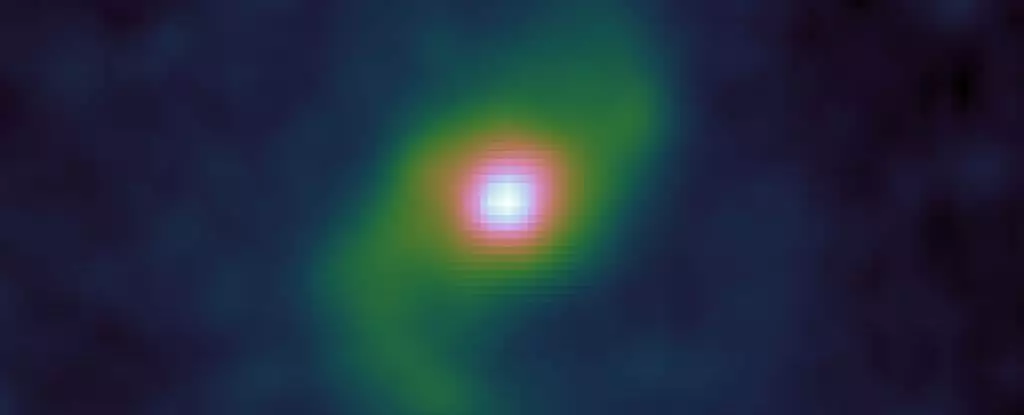The cosmos has a way of constantly challenging our understanding of its vast intricacies. Recently, astronomers unveiled a massive spiral galaxy, identified as J0107a, that emerged just 2.6 billion years after the Big Bang. What’s stunning is that this galaxy features a remarkably evolved structure—a stable galactic bar—traditionally thought to characterize older galaxies. The implications of this discovery are profound, compelling scientists to reconsider their long-standing assumptions about galaxy formation.
Historically, astronomers envisioned galaxies as evolving gradually, beginning with black holes. These black holes were perceived as the seeds from which gas would accrete, eventually leading to the formation of stars and galactic structures like spiral arms. However, the revelation of J0107a complicates this narrative. Its existence suggests that sophisticated cosmic creations were forming much sooner than previous theories had suggested, thereby igniting an inquisitive spark across the astronomical community.
Galactic Bars: A Paradigm Shift in Understanding
The role of galactic bars in cosmic evolution cannot be overstated. Typically, these elongated structures, composed of stars, serve as vital conduits, channeling gas toward a galaxy’s center. This gas plays a crucial role in star formation, and the distribution and dynamics of this gas are fundamental to understanding a galaxy’s life cycle. Yet, the discovery of J0107a alters the conventional wisdom surrounding bars, which were primarily associated with more mature galaxies.
Astronomer Shuo Huang and his team utilized advanced technologies, including observations from the Atacama Large Millimeter/submillimeter Array (ALMA) and the James Webb Space Telescope (JWST), to analyze J0107a’s stellar and gaseous makeup. Their findings reveal that the gas dynamics within J0107a closely resemble those found in present-day galaxies like the Milky Way. This astonishing similarity raises significant questions: Has our understanding of the timeline for galactic evolution been too conservative?
It seems plausible that J0107a is a cornerstone for understanding the evolution of galaxies during the Universe’s early stages. Initially thought to be a slow process with ample time for gradual development, J0107a’s well-defined structure implies that galaxies could form rapidly under specific cosmic conditions.
Reevaluating the Cosmic Web Connection
One of the striking theories emanating from these findings is the influence of the cosmic web—an intricate structure stitching together galaxies and intergalactic matter. Huang suggests that J0107a formed not merely through the collection of gas but rather might have been significantly shaped by a vast inflow of gas from this cosmic network. This challenges previously held views of how galaxies evolve; if J0107a is correct in depicting a large galaxy forming with basic internal structures so early on, it underscores how interconnected galaxies are, even at such an early epoch.
This cosmic web potentially facilitates the inflow of vast hydrogen gas, crucial for star formation. The flow of gas toward regions of high density can accelerate galactic growth, allowing formations that might have traditionally been relegated to a later stage of cosmic evolution. J0107a exemplifies this phenomenon as it operates at around ten to one hundred times the gas flow rates observed in contemporary galaxies, unlocking a new dimension of inquiry regarding early star formation conditions.
Pushing the Boundaries of Astronomy
While these discoveries open new frontiers, one must consider the complex dance between observation and theory. Huang notes a critical gap in our understanding regarding the density of gas and its role in nurturing star formation. While J0107a’s gas might instigate star birth, the exact processes could diverge significantly from those in more evolved galaxies. This insight necessitates a comprehensive rethink of existing models, further complicating the narrative of cosmic evolution.
The mystery surrounding the early Universe is intensifying. With each discovery, we peel back layers of complexity, revealing cosmic truths once thought unattainable. Astronomers are faced with the exhilarating task of reconceptualizing frameworks to accommodate these early, intricate phenomena.
The Future of Galactic Studies
As the study of J0107a and galaxies similar to it continues, the astronomical community stands at a precipice of discovery. Future observations will undoubtedly refine our understanding of galaxy formation during the Universe’s evolution. The call to arms for scientific inquiry resonates louder than ever, urging a deeper exploration of the cosmic mechanisms at play.
J0107a is just one example among an increasing number of early spiral galaxies, each contributing valuable knowledge that may ultimately reshape our perspective on the formation and evolution of galaxies. In unveiling the remarkable similarities between young galaxies and their older counterparts, we inch ever closer to unlocking the secrets of our cosmic origins. The possibilities are as vast and intricate as the galaxies themselves, and the journey is only beginning.


Leave a Reply